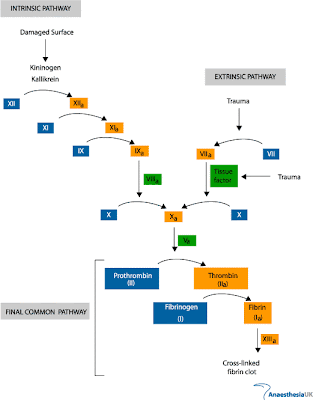
Cerebrovascular Accident
Definition
The sudden death of some brain cells due to lack of oxygen when the blood flow to the brain (corresponding loss of neurologic function) is impaired by blockage or rupture of an artery to the brain. A CVA is also referred to as a stroke. TIA vs. CVA
Risk Factors
· Age
· Hypertension**
· Prior TIA/CVA
· Diabetes mellitus
· Hypercholesterolemia
· Smoking!
· Atrial fibrillation
Causes
1. Ischemic
o Thrombotic
§ Virchow’s Triad
o Embolic
o Hypoperfusion
2. Hemorrhagic
o Primary
o Hemorrhagic transformation
Virchow’s Triad
· Venous Stasis
o Phenomena of interrupted blood flow
· Endothelial Injury
o phenomena associated with irritation of vessel and its vicinity
· Hypercoaguability
o phenomena of blood coagulation
Hypercoaguability can be
Congenital
· Antithrombin III deficiency
[Antithrombin III - protein that inactivates the intrinsic pathway (Factor X (Xa), IX (IXa), XI (Xia), XII (XIIa), II (Iia) and the extrinsic pathway (Factor VII (VIIa), kallikrein and plasmin, C1 of complement pathway (can also be seen as acquired)]
· Protein C & S deficiency
· Factor V Leiden
· Prothrombin mutation
· MTHFR mutation (homocysteine)
Acquired
· Antiphospholipid antibodies
o Anti-cardiolipin Ab/lupus anticoagulant
· HIT
· Paroxysmal Nocturnal Hemoglobinuria
· Nephrotic syndrome
· OCP’s
· SMOKING!!!
· Malignancy
Symptoms of a stroke depend on the area of the brain affected. The most common symptom is weakness or paralysis of one side of the body with partial or complete loss of voluntary movement or sensation in a leg or arm. There can be speech problems and weak face muscles, causing drooling. Numbness or tingling is very common. A stroke involving the base of the brain can affect balance, vision, and swallowing, breathing and even unconsciousness.
· Face weakness/asymmetry
· Extremity drift or weakness
· Abnormal speech +/- Aphasia
· Unilateral
· Ataxia +/- Vertigo
· Anosognosia
· Loss of Conciousness
Facial Asymmetry
Major Cerebral Arteries
Internal Carotid Artery
· Terminal branch of Common Carotid
· Cervical (C1), Petrous (C2), Lacerum (C3), Cavernous (C4), Clinoid (C5), Ophthalmic (C6), Communicating (C7) segments
Ophthalmic Artery Occlusion
· Ocular Ischemic Syndrome
o Usu. Age 50-80
o M:F 2:1
o Dull radiating ache of eye/brow
o Intractable pain (ocular angina)
o Blot retinal hemorrhage/beaded retinal veins
· Amaurosis Fugax (acute vision loss from reduced blood flow to the eye - warning sign of impending stroke Caused by severe ipsilateral / b/l carotid a. stenosis/occlusion, takayasu’s arteritis, giant cell arteritis, optho a. thromboembolism If 2* carotid a. embolism/occlusion, possible for migration to end a. of brain)
· Transient blurred vision
· Retinal artery occlusion
Amaurosis Fugax Attack
· Anterior Cerebral Occlusion
· Frontal lobe, anterior basal ganglia and internal capsule function
· Disinhibition
· Primitive reflex production
· Altered mental status
· L side CVA ® aphasia
· Contralateral weakness (legs>arms)
· Contralateral sensory deficits
· Gait apraxia
· Urinary incontinence
Middle Cerebral Occlusion
· Majority lateral aspect of frontal, parietal lobes, inferior temporal lobe
· Contralateral hemiparesis
· Contralateral sensory deficits
· Ipsilateral/homonymous hemianopsia
· Gaze preference
· Agnosia
· R CVA ® Contralateral Neglect
· Extremity weakness (upper>lower)
Posterior Cerebral Occlusion
· Occipital lobe
· Contralateral homonymous hemianopsia with macular sparing
· Cortical blindness
· “Medial Midbrain Syndrome”
· Altered mental status
· Impaired memory
· “Prosopagnosia” -visual agnosia
· Ipsilateral deficits CN V, VIII, IX, X & XI
Lacunar Occlusion
· Small perforating arteries of deep subcortical areas of the brain
· Lesions occur in deep nuclei of the brain
o Putamen (37%)
o Thalamus (14%)
o Pons (16%)
o Caudate (10%)
o Internal capsule - posterior limb (10%)
o Deep cerebral white matter, anterior limb internal capsule and cerebellum less common)
(13-20% of all infarctions occur in pts with small vessel dz such as HTN, DM.They are small in size, well defined -> do not lead to impairments in cognition, memory, speech or level of consciousness Better survival rates at 30 days (96-97%) vs other (85%), 1 year (87% vs. 65-70%) with greater functional independence at 1 year (70-80% vs. 50%))
Lacunar Syndromes
Pure Motor (30-35%)
· Infarction posterior limb internal capsule
· Hemiparesis/hemiplegia
· Dysarthria
· Dysphagia
· Transient sensory symptoms
Pure Ataxic
· Infarction of posterior limb internal capsule, basis pontis & corona radiata
· Cerebellar and Motor symptoms
· Ipsilateral weakness
· Clumsiness
o Usually affects leg > arm (homolateral ataxia)
Dysarthria/Clumsy Hand
· Variant of ataxic hemiparesis
· Infarction in the pons
· Dysarthria
· Clumsiness of the hand
o Most prominent when the patient is writing
Pure Sensory
· Infarction in contralateral thalamus
· Persistent/transient
o Numbness
o Tingling
o Pain
o Burning
o Unilateral “unpleasant sensation”
Mixed Sensorimotor
· Infarction in thalamus & adjacent posterior limb internal capsule
· Hemiparesis or hemiplegia
· Ipsilateral sensory impairment
(Hemiparesis - weakness on one side of the body
Hemiplegia - paralysis on one side of the body)
Treatment
· ABC’s!!
· BP control is SBP >220, DBP >120
o Not rapidly!
o SBP >185, DBP >110 is contraindication for TPA
o Clinically (aim SBP 160-180)
TPA
· Must present within 3 hours of onset of Sx with severe neurologic deficit
· Excluded
o Sx suggestive of SAH
o Previous Hx intracranial hemorrhage
o Recent CVA or MI (within 3 mo)
o Recent head injury (within 3 mo)
o Recent major surgery (within 14 days)
o Heparin/anticoagulants (within 48 hours)
o Thrombocytopenia (<100 x9)
o Hypo/hyperglycemia (<50, >400)
Radiology
· CT Head
o With or without contrast?
o r/o intracranial hemorrhage
· Neurology Consult
o Repeat CT 48hrs (r/o hemorrhagic conversion)
o MRI / EEG / Carotid Dopplers / 2D Echo
· Antiplatelets vs. Aggrenox
· Cardiology Consult
o Arrythmia contributer?
· Speech Evaluation
· Rapidly Expanding Hematoma







No comments:
Post a Comment